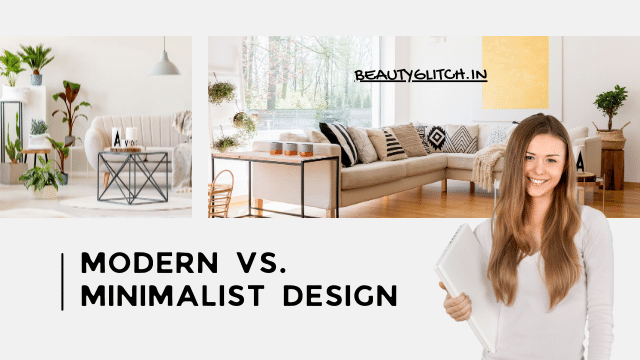Although you may have heard the terms “modern” and “minimalist” in reference to interior design, you’re probably wondering how to distinguish between the two. While there are several similarities between modern and minimalist styles, subtle differences can help you tell them apart. The modern decor combines form and function, while minimalism focuses only on the functionality of a piece. Whereas a modern room might use pillows or fun boho decor to accent its muted color scheme, minimalism opts for items that serve a specific purpose. When looking at modern vs. minimalist design, pay attention to function, space, and materials.
Origins of Modern and Minimalist Design
Both modern and minimalist styles have origins in Mid-Century Modern designs. After the second world war, German architects who immigrated to the United States began implementing industrial elements into furniture and architecture. This resulted in clean, functional frames on furniture like coffee tables, couches, and chairs. The upholstery in Mid-Century Modern design was anything but plain, however, and included bold oranges, blues, yellows, greens, and vibrant patterns.
Similarities of Modern and Minimalism
The roots of modern and minimalism design are found in Mid-Century Modern elements. This gives each style similar features, including:
- Clean lines
- Simplicity
- Less ornate
- Geometric shapes
- Natural wood
- Rounded edges
- Warm tones
- Lifted furniture
Whereas Mid-Century Modern used bold patterns and attractive colors, minimalist and contemporary decor use neutral colors with one or two colorful accessories to create bold accents. In a room with modern style, you might find beige furniture and neutral-toned wood with a brightly colored tapestry blanket or throw pillows with a pop of color on a gray or white couch. In a room with a minimalist scheme, you would be more likely to find an accordion hook rack that serves a functional purpose.
Subtle Differences Between Minimalism and Modern
If you want to revamp your space in a modern or minimalist design, it’s important to familiarize yourself with the specific differences between the two. Although they are very similar, there are a few differences that make each one stand out.
-
Function
The first area of differentiation is functionality. Minimalism as a lifestyle has its roots in Buddhism and aims to celebrate life by removing anything that distracts you from being fully present at the moment. The minimalist design embraces this concept. A minimalist space is decluttered, boasts clean, sleek lines and open space, and only utilizes pieces that perform a function within the room. This means no extraneous decorations or furniture.
The modern decor uses the same basic ideas as minimalist design, but it focuses on the form of the piece. A modern space might be less stark than a minimalist area and use a wider array of textiles and colors to brighten the space. For a modern design, keep things simple and clean. Also, add in pieces that bring more personality to the room. A unique art piece that is purely for viewing and has no function might not work in a minimalist space, but you can easily incorporate it into a modern room.
-
Space
The minimalist design also focuses on how pieces exist in the space. When decorating in this style, you want to think about how the pieces interact in the room. They should perform an essential function, allow for ample room to move around, let in natural light and utilize texture to create a visually interesting space. Above all else, a minimalist design should use only the essentials to create a harmonious, relaxed setting in your room.
While a minimalist design creates a sparse yet harmonious space, a modern design allows for more creativity and comfort over functionality. For a modern room, focus on how your decor plays with lighting and shapes to create a clean, simple look accented by geometric shapes and one or two accessory focal points. Mirrors are a great way to play up the natural light in a space, and adding a plant or two is another option for emphasizing the natural, earthy vibes of modern design.
-
Materials
The materials used in minimalist decor allow for simple lines and shapes, highlighting the material’s natural beauty. A minimalist space uses materials that are either all-natural or colored white, beige, and gray. Textiles like linen, wool, and cotton work well with minimalist designs, as do wood furniture and accessories.
Unlike minimalist design, the modern look allows for different materials to be incorporated into the scheme. Earth-toned metal accessories or a simple glass table highlight the elegant, airy feel of the contemporary room. Tiles with a subtle geometric pattern or hard-wood floors give movement to the area, and a cotton canvas wall hanging adds depth and texture. White, gray, or beige linen curtains work to keep the light, bright feel to the space, and light-colored wool throw blankets add warmth without cluttering the area.
Decorating Your Space
Switching to a minimalist or modern design scheme requires an intentional choice of the items you choose to place in the room. If you are designing a room from scratch, it might be easy to determine which elements to include, buy them, and arrange your room. However, if you want to make the change but live in a non-modern or minimalist space, you can follow a few tips to make the transition without spending a lot of money.
- Move everything out of the space. If possible, paint the walls a neutral color.
- Utilize minimalist principles, and bring in only the essential items you need to function.
- Add modern decor elements to personalize the area.
- Purchase new bedding in a neutral tone. Invest in one or two solid-colored pillows.
- Remove heavy curtains and opt for light-weight material or use simple blinds.
- Get organized and have a dedicated place for everything.
- Continue exchanging accessories and furniture pieces as time and money allow.
Start with Minimalist and Modern Design
While it’s helpful to distinguish between minimalist and modern designs when redecorating your space, it’s even more important to stay true to your personal style. The great thing about these two design schemes is that they are an excellent base for adding elements that personalize your space. Minimalism is great for decluttering and embracing functional living, but it can feel stark and impersonal. The modern design encourages a monochrome color palette and comfort combined with function, and it builds on the minimalist style. Whether you choose to go all-in with one or the other or start with the basics and build into your own style, your space reflects your inner sense of happiness and peace.

